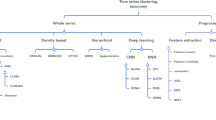Abstract
Due to the high mortality associated with heart disease, there is an urgent demand for advanced detection of abnormal heart beats. The use of dynamic electrocardiogram (DCG) provides a useful indicator of heart condition from long-term monitoring techniques commonly used in the clinic. However, accurately distinguishing sparse abnormal heart beats from large DCG data sets remains difficult. Herein, we propose an efficient fine solution based on 11 geometrical features of the DCG PQRST(P-T) waves and an improved hierarchical clustering method for arrhythmia detection. Data sets selected from MIT-BIH are used to validate the effectiveness of this approach. Experimental results show that the detection procedure of arrhythmia is fast and with accurate clustering.












Similar content being viewed by others
References
Tu, Y.W., Chen, H., Fu, X.Q., et al., Beats clustering based algorithm for fast recognition of motion artifact sections in Holter system[J]. J. Zhejiang Univ. Eng. Sci. 46(6):1148–1156, 2012.
Tu, Y.W., Yu, X.M., Chen, H., and et al., A novel method for the detection of sleep apnea syndrome based on single-lead ECG signal[C]. Appl. Mech. Mater. Trans. Technol. Publ. 239:1079–1083, 2012.
Gang, Z., Yalou, H., and Pengtao, W., Study of Classficication Rules on Weighted Coronary Heart Disease Data[C], pp. 1845–1850. Guangzhou: Proceedings of the Fourth International conference on Machine Learning and Cybernetics, 2005.
Ghongade, R., and Ghatol, A.A., brief performance evaluation of ECG feature extraction techniques for artificial neural network based classification[C]. In: TENCON 2007-2007 IEEE Region 10 Conference, pp. 1–4. IEEE (2007)
Jiawei Han, M.K., and Pei, J., Data mining: Concepts and Techniques, Concepts and Techniques[J] (2011)
Yue, Q., Research of clustering strategies for dynamic electrocardiogram waveform Tianjin University of Technology (2008)
Desai, U., Martis, R.J., NAYAK C, G., and et al., Decision support system for arrhythmia Beats using ECG signals with dct, dwt and Emd methods: a comparative study[J], p. 1640012: Journal of Mechanics in Medicine and Biology, 2016.
Li, N., Yang, Z., Sun, L., and Wei, R., Extraction method based on Q wavelet transform of ECG signal characteristic. Comput. Sci. 41:61?-64, 2014.
Pang, Z., The comparison of dynamic electrocardiogram and common electrocardiogram in diagnosis coronary heart disease. China Foreign Med. Treat. 28(13):1–1, 2009.
Perren, F., Gschwind, M., Landis, T., and et al., Multiple sclerosis relapse mimicking a transient ischemic attack[J]. Mult. Scler. Relat. Disord. 5:27–28, 2016.
Banerjee, S., and Mitra, M., ECG feature extraction and classification of anteroseptal myocardial infarction and normal subjects using discrete wavelet transform[C]. In: 2010 International Conference on Systems in Medicine and Biology (ICSMB), pp. 55–60. IEEE (2010)
Mao X, M., Zhang T, T., and LI, Q., ECG Clustering algorithm based on ARMA[j]. Chin. J. Biomed. Eng. 6:004, 2012.
Chen, H.C., and Chen, S.W., A moving average based filtering system with its application to real-time QRS detection[C]. In: Computers in Cardiology, 2003, pp. 585–588. IEEE (2003)
Li, N., and Yang, Z., The application of frequency slice wavelet transform in ECG signal feature Extraction[J]. J. Fiber Bioeng. Inf. 8(3):461–472, 2015.
Xu, J., A-ming, W., and Zheng, X., Analysis of ECG Signals Based on Wavelet Threshold De-noising[J]. Comput. Simul. 12:068, 2011.
Wang, Y., and Zeng, D., Processing of ECG signal based on compared with wavelet denoising and the EMD de-noising in quantitative. J. Numer. Methods Comput. Appl. 32:274–282 , 2011.
Yuan, F., Research about noise pocessing of ECG signals. Electron. Tecnol. 5:130–131, 2014.
Zhang, X., and Xu, Z., Hesitant fuzzy agglomerative hierarchical clustering algorithms[J]. Int. J. Syst. Sci. 46(3):562–576, 2015.
Jing, Y., Zhou, Q., and Chen, W., An improved template matching algorithm and its application in ECG waveform recognition. Chin. J. Biomed. Eng. 31(5):775–780, 2012.
Ge, D., and Weng, J., Discrimination of myocardial infarction based on 2d-LDA and high frequency electrocardiogram. Space Med. Med. Eng. 26(2):125–130, 2013.
Yuan, Z., Li, J., and Zhang, B., A weighting system clustering method and application. J. Shenyang Univ. Nat. Sci. 26(3):201–207, 2014.
Ma, Y.J., and Yun, W.X., Research progress of genetic algorithm[J]. Jisuanji Yingyong Yanjiu 29(4), 2012.
Bushra J., Olivier L., Eric F., et al.: Detection of QRS complex in ECG signal based on classification approach[C]. In: 2010 17th IEEE International Conference on Image Processing (ICIP), pp. 345–348. IEEE (2010)
Liu, J., Analysis of ECG signal and software implement beijing jiaotong university (2010)
Liu, S., Research on clustering in typical character of ECG by fuzzy C-Means Zhejiang University (2006)
Acknowledgments
This research is sponsored by National Natural Science Foundation of China (No.61171014, 61371185, 61401029, 61472044, 61472403, 61571049), Beijing Advanced Innovation Center for Future Education (BJAICFE2016IR-004), the BNU Graduate Students’ Platform for Innovation & Entrepreneurship Training Program (No.1601121E1), the Fundamental Research Funds for the Central Universities (No.2014KJJCB32, 2013NT57) and by SRF for ROCS, SEM.
Author information
Authors and Affiliations
Corresponding author
Additional information
This article is part of the Topical Collection on Patient Facing Systems
Rights and permissions
About this article
Cite this article
Bie, R., Xu, S., Zhang, G. et al. Efficient Fine Arrhythmia Detection Based on DCG P-T Features. J Med Syst 40, 168 (2016). https://doi.org/10.1007/s10916-016-0519-0
Received:
Accepted:
Published:
DOI: https://doi.org/10.1007/s10916-016-0519-0




